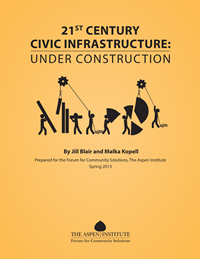21st Century Civic Infrastructure: We Must Build It So All Can Come

The collective impact movement is beginning to shift the landscape of place-based investment. It is proving its greatest value as a formula for building community capacity to solve public problems. However, in order for communication, resources and action to move across the various players in collective impact efforts, a healthy civic infrastructure must facilitate public engagement.
What Is Civic Infrastructure?
Civic infrastructure is made up of places, policies, programs and practices that enable us to connect with one another, to address our shared concerns, to build community and to solve public problems. It is this basis upon which ordinary people are able to participate in ordinary civic life—from joining neighborhood watch groups to entering the voting booth. In this frame, collective impact is a part of civic infrastructure but does not represent civic infrastructure in its entirety.
In exploring the making and meaning of 21st century civic infrastructure, Malka Kopell and I conclude that like the bridges and tunnels, railroads and water systems that comprise our physical infrastructure, a well-designed civic infrastructure can enable us to live more relational and economically vibrant lives.
The Keystones of a 21st Century Civic Infrastructure
So, what are the critical elements of 21st century civic infrastructure? That is, how can we know what rises to the challenge of the 21st century problems we face? We offer the following three, deceptively simple keystones and related areas of inquiry to move our thinking and actions forward:
Engaging All Sectors
The 21st century is a time when the boundaries between sectors are dissolving. We are beginning to understand that our society’s interconnected problems affect us all—from income inequality and the education achievement gap to climate change and our dependence on fossil fuels. We should mindfully support those efforts seeking to engage all sectors in the problem-solving enterprise.
When and why do we resist setting more places at the table for cross-sector participation? When and why do those in whom we invest welcome public and private sector participation in their work? What more do we need to learn and share to be better partners with others?
Enlisting All Voices
We have more tools and technologies for real-time feedback than ever before. Let’s employ these tools to hear the voices of those whose lives we seek to improve—those on the margins who must be brought to the center.
Who qualifies as on the margins in the work we support and do, and how are we hearing their voices? When are the voices of ordinary people incorporated into the strategies we support and undertake, and how are they incorporated? Who are our constituents and how do we engage with and listen to them?
Exchanging All Practice and Knowledge
Our 21st century civic infrastructure must include capacity to move information, knowledge, policy and practice from local to national and back to local. Just as important, we need to make the commitment to exchange wisdom, practice, policy and knowledge horizontally as well—between and among like-minded efforts.
To what extent are we communicating with others in our fields of practice/interest and to what end? To what extent should and do those in whom we invest seek to contribute and influence public policy—to scale their success by sharing it? Where are we sharing with and learning from others, and how are we putting that learning into practice?
The keystones provide a basis for assessing how well we are faring at leveraging 21st century resources to address 21st century challenges. We hope they stimulate and serve as the basis for community conversations wherein people come together to consider how to strengthen, supplement or reinvent local civic infrastructure. Philanthropy has an important role to play, but should not be alone in this endeavor. We all have a stake in creating the strongest possible foundation for the greatest possible participation of ordinary people in ordinary life.
Creating the Space for “Better Together”
Collective impact joins the ranks of other cooperative and collaborative problem solving efforts—different approaches with a common underlying belief in “better together.” In placing these public problem-solving remedies in a broader organizing frame, we can hold and connect a multiplicity of healing endeavors. The concept of civic infrastructure is such a frame: it is a timeless, meaningful metaphor under which we can continue to create, cultivate, reform and revise the therapies we require to heal our communities and continue our pursuit of economic and social justice for all.
 We’re pleased to welcome Jill Blair, a founding partner of Informing Change when it was known as BTW– informing change, as a guest blogger. Currently, Jill is a Strategy and Organization Consultant to nonprofits and philanthropies. In the fall of 2014, Jill was commissioned by the Aspen Institute Forum for Community Solutions to explore the meaning and making of 21st century civic infrastructure. The product of that effort is the recently released monograph, 21st Century Civic Infrastructure: Under Construction, co-authored with Malka Kopell, a long-time leader and consultant in the civic engagement field.
We’re pleased to welcome Jill Blair, a founding partner of Informing Change when it was known as BTW– informing change, as a guest blogger. Currently, Jill is a Strategy and Organization Consultant to nonprofits and philanthropies. In the fall of 2014, Jill was commissioned by the Aspen Institute Forum for Community Solutions to explore the meaning and making of 21st century civic infrastructure. The product of that effort is the recently released monograph, 21st Century Civic Infrastructure: Under Construction, co-authored with Malka Kopell, a long-time leader and consultant in the civic engagement field.

